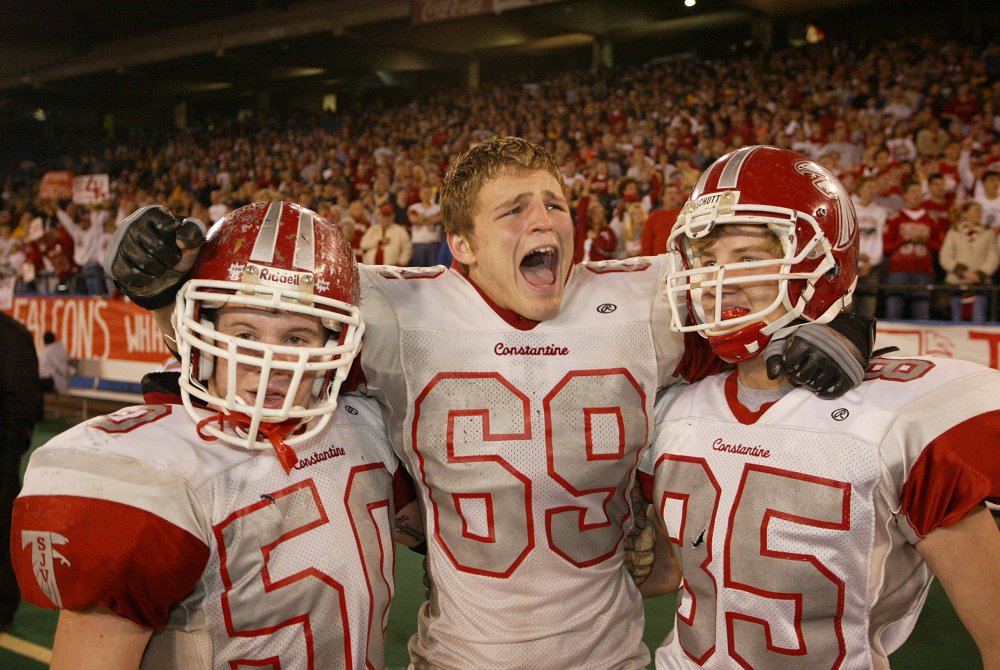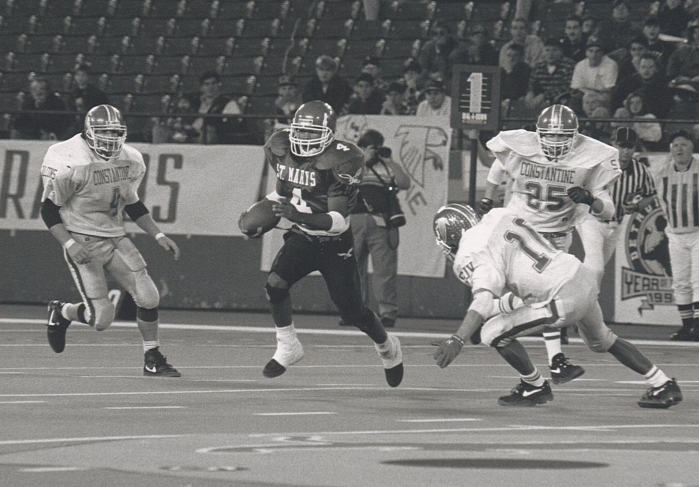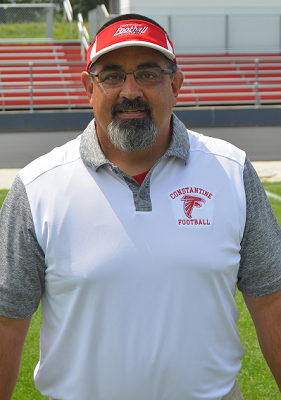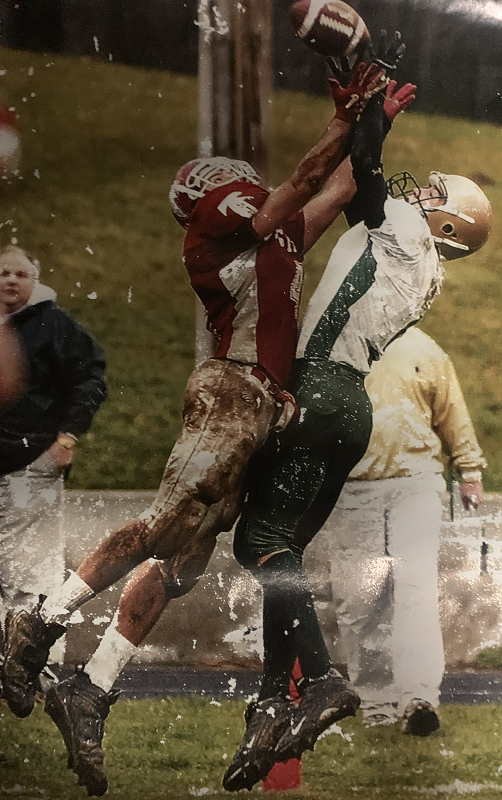
Inside Selection Sunday: Mapnalysis '19
By
Geoff Kimmerly
MHSAA.com senior editor
October 27, 2019
This will be the final MHSAA Football Playoffs under the format created in 1999, with significant changes coming beginning with the 2020 season.
But the soon-to-be old way isn’t going out without a bang.
From a record number of additional qualifiers, to a first-ever coin flip to determine the final team in the 11-player field, to a series of maps that arguably included the toughest to draw at least this decade, this year’s “Selection Sunday” was jammed with notable moments that will play out in 10 divisions over the next five weeks.
Below, we explain how we made many of the most difficult decisions – and follow with a few points of interest that immediately jump out from this season’s brackets.
This process actually begins in April, when we start collecting schedules for the upcoming season – this time for 607 teams, from which 531 ended up eligible for the 11-player playoffs and 71 were eligible in 8-player. And of course, now that the brackets are drawn the major lifting begins – assigning officials for every game, gathering potential Semifinal sites in 11-player and working with our Finals hosts to again create once-in-a-lifetime experiences (for most) when our 8-player finalists face off Nov. 23 at Northern Michigan University’s Superior Dome and our 11-player finalists play for titles Nov. 29-30 at Ford Field.
So let’s dive in. Those familiar with this “Selection Sunday” recap will recognize first a refresher on the playoff selection process, followed by “Observations & Answers: 2019.” That’s followed by thoughts after a glance at this year’s brackets, and be sure to visit MHSAA.com to see all of the pairings in full.
Ground Rules
Our past: The MHSAA 11-player playoff structure – with 256 teams in eight divisions, and six wins equaling an automatic berth (or five wins for teams playing eight or fewer games) – debuted in 1999. An 8-player tournament was added in 2011, and in 2017 a second division of 8-player football was introduced.
The first playoffs were conducted in 1975 with four champions. Four more football classes were added in 1990 for a total of eight champions each fall. Through 1998, only 128 teams made the postseason, based on their playoff point averages within regions (four for each class) that were drawn before the beginning of the season. The drawing of Districts and Regionals after the end of the regular season did not begin until the most recent 11-player playoff expansion.
In early years of the current process, lines were drawn by hand. Dots representing qualifying schools were pasted on maps, one map for each division, and those maps were then covered by plastic sheets. Districts and Regionals literally were drawn with dry-erase markers.
Our present: The last few scores of this regular season were added to MHSAA.com by 8 p.m. Saturday. Re-checking and triple-checking of enrollments, what schools played in co-ops and opted to play as a higher class start a week in advance, and more numbers are crunched Sunday morning as the fields are set.
This final season of 6-wins-and-in (or five wins playing eight games or fewer) produced 202 automatic qualifiers for the 11-player field with a record 54 additional qualifiers then selected by playoff point average – that group of additional qualifiers easily blowing past last year’s then-record total of 43. Additional qualifiers were selected from each class in order (A, B, C, D) until the field was filled. There were only two Class D additional qualifiers with 5-4 or 4-4 (playing eight games) records from which we could choose, and likewise there were 16 additional qualifiers available in Class C – so with those 18 spots filled, we added 18 teams from both Class A and B to fill out the field.
Here’s where the tie-breaker was forced into play. Among Class B teams, Durand and Imlay City tied for the 18th spot with playoff point averages of 42.667. They did not play each other during the regular season – so the first tie-breaker of head-to-head result couldn’t be used. The next tie-breaker is opponents’ winning percentage – and both teams’ opponents won 45.7 percent of their games this season. So we went to the coin flip, and Durand was awarded the final spot in the field.
Those 256 11-player teams were then split into eight equal divisions based on enrollment, and their locations were marked on digital maps then projected on wall-size screens and discussed by nearly half of the MHSAA staff plus two representatives from the Michigan High School Football Coaches Association. Only the locations themselves were marked (by red dots) – not records, playoff point averages or names of the schools or towns. In fact, mentions of those are strictly prohibited. Records and playoff points are not part of the criteria. Matchups, rivalries, previous playoff pairings, etc. also DO NOT come into play.
The 8-player process is different for team selection and similar for designation of Regionals. We take the top 32 teams in 8-player based on playoff point average as our field, then re-sort those 32 by enrollment – the 16 biggest make up Division 1, followed by the next 16 in Division 2. There are no automatic qualifiers by record for 8-player, and those fields remain in flux right through the last Week 9 games. For example: Colon as recently as after Week 7 was slated for Division 2. But the Magi after this weekend ended up in Division 1 with the second-highest playoff-point average but the 16th-highest enrollment – meaning Colon (160 students) and Cedarville (154) were the line between Divisions 1 and 2 this year.
Our future: 11-player divisions determined in March. More bonus points awarded in losses. Read all about it: Comparison of old and new playoff formats
Geography rules: This long has been rule number one for drawing MHSAA brackets in any sport. Travel distance and ease DO come into play. Jumping on a major highway clearly is easier than driving across county-wide back roads, and that’s taken into consideration. Also, remember there’s only one Mackinac Bridge and hence only one way to cross between peninsulas – and boats are not considered a possible form of transportation. When opponents from both peninsulas will be in the same District, distance to the bridge is far more important than as the bird flies.
Tradition doesn’t reign: Every group of 32 (or in 8-player, 16) dots is a new group – these 32 teams have not been placed in a bracket together before. How maps have been drawn in the past isn’t considered – it’s hard to say a division has been drawn in a certain way traditionally when this set of 32 teams is making up a division for the first time.
Observations & Answers: 2019
We always start with CONGRATULATIONS: Detroit Leadership Academy, Detroit Communication Media Arts, and Pellston will be making their debuts in the MHSAA Playoffs this week, taking the list of teams that have never qualified for the postseason down to 11. Beal City and Crystal Falls Forest Park will make their MHSAA-best 35th playoff appearances. Five teams will be playing in at least their 17th consecutive playoffs – Rockford (25), Forest Park (23), Jackson Lumen Christi (22), Macomb Dakota (20) and Climax-Scotts (17).
Head-to-head rules: As noted above, it’s the first tie-breaker and comes into play immediately this week. In Division 3, East Lansing and DeWitt have identical playoff point averages, and East Lansing will host their first-round game thanks to a 21-2 Week 5 win. If Portland and Lansing Catholic both advance to an 11-Player Division 5 District Final, Portland will host thanks to a 21-20 Week 5 win over the Cougars. Same in 8-player Division 2, where if Powers North Central and Pickford meet in a Regional Final, the Jets will host thanks to their 20-14 win when the teams met in Week 3.
 Traverse City traveling: Many years, we have to pay special consideration to ease of travel when we have one of 32 teams from a division in the Upper Peninsula. This year, we spent a lot more time discussing Traverse City schools – notably how to position Traverse City West in Division 1 and Traverse City Central in Division 2. There are three main north-south highways in the Lower Peninsula, with U.S. 131 the thoroughfare out of Traverse City. We also used it as the defining line in Division 1, with West going west with Grand Haven, Grandville and Hudsonville instead of staying with a more northern group that would’ve included Rockford and split Grandville and Hudsonville – which are six miles apart down I-196. In Division 2, we brought U.S. 127 into the mix, figuring it made more sense for travel to use that and 131 in grouping Traverse City Central with Muskegon Mona Shores, Midland and Midland Dow instead of creating a western District stretching from Traverse City to south of Kalamazoo.
Traverse City traveling: Many years, we have to pay special consideration to ease of travel when we have one of 32 teams from a division in the Upper Peninsula. This year, we spent a lot more time discussing Traverse City schools – notably how to position Traverse City West in Division 1 and Traverse City Central in Division 2. There are three main north-south highways in the Lower Peninsula, with U.S. 131 the thoroughfare out of Traverse City. We also used it as the defining line in Division 1, with West going west with Grand Haven, Grandville and Hudsonville instead of staying with a more northern group that would’ve included Rockford and split Grandville and Hudsonville – which are six miles apart down I-196. In Division 2, we brought U.S. 127 into the mix, figuring it made more sense for travel to use that and 131 in grouping Traverse City Central with Muskegon Mona Shores, Midland and Midland Dow instead of creating a western District stretching from Traverse City to south of Kalamazoo.
Avoid the crisscross: Sometimes Districts drawn on the maps look perfect – but we run into trouble putting them together for a logical Regional. Sometimes we know eight dots should be a Regional, but there’s no reasonable way to split them into two four-team Districts. We do everything possible to keep a team from driving past a different District (or in 8-player Regional) on the way to its first or second-round game. The 8-Player Division 1 map probably looks a little odd with Deckerville possibly playing Morrice in the second round and the Orioles driving past Mayville or Kingston from another Regional to get there. However, there is a distinct northeast-to-southwest line separating those four schools – and if the Regional had been drawn to keep Deckerville with Mayville and Kingston, it would’ve meant Regional champs “jumping” over each other for their Semifinal matchup.
North/South vs. East/West: There isn’t one guiding directional when creating these Districts and Regionals. The 11-player Division 7 map has a little bit of both, with a pair of Districts along I-94 on the south side of the Lower Peninsula, but then Madison Heights Bishop Foley grouped with three Thumb-area teams for a north-south grouping. The other option was sending Bishop Foley northwest toward Flint and Lansing, but that would’ve left the Thumb schools and Beaverton maneuvering around Saginaw Bay.
At the end of the day …
Here’s my annual reminder: We draw these maps not knowing which schools are represented by the dots. The Division 5 and 6 maps were so easy to draw, I had no idea which schools were matched up until checking out the brackets hours later to put together this report.
But with all of that in front of me, here’s a glance at what jumps off the page:
• The Division 1 District made up of unbeaten Belleville and Brownstown Woodhaven, Saline (8-1) and Ann Arbor Pioneer (5-4) is obviously loaded. Belleville and Saline both made the Semifinals last season, and Saline’s only loss this fall was to reigning Division 1 champion Clinton Township Chippewa Valley. Woodhaven finished the regular season unbeaten for the second time in six years and its seeking its first District title.
• Last season’s Division 4 champion Edwardsburg has won 23 straight games and is back in the Division 3 bracket – the Eddies played in Division 4 the last two seasons and most recently in Division 3 in 2016. A possible return to Ford Field starts this week with St. Joseph and could include a trip to Zeeland West and matchup with also-unbeaten Mason.
• Hudsonville Unity Christian is another reigning champion in a new division, moving into Division 4 after winning the championship in Division 5 last fall. Unity begins with Otsego and would play either Grand Rapids Christian or South Christian with a win.
• Make way for Division 7. Unbeaten New Lothrop is the reigning champion and shares a District with undefeated Beaverton and a Regional with also-undefeated Pewamo-Westphalia. Iron Mountain, Lawton, Jackson Lumen Christi and Clinton also have yet to lose a game this season. Lumen Christi has won the last three Division 6 championships and 31 straight games.
• Math can lead to some unpredictable situations, including the occasional undefeated road team during the first round. Almont defeated Richmond 28-10 in Week 7 on the way to the Blue Water Area Conference title and a perfect regular-season record. But the Raiders will travel this week back to Richmond because the Blue Devils finished with a better playoff point average – Almont’s two nonleague opponents finished a combined 1-17, and Richmond’s both made the playoffs with a combined 13-5 record. That difference made the difference in playoff point average by about nine-tenths of a point in Richmond’s favor.
• This year’s 8-player brackets are loaded with intrigue, especially with 2018 Division 2 champion Rapid River not in the field and last year’s Division 1 runner-up Pickford in Division 2 this time. Morrice is the reigning Division 1 champion and could see undefeated Deckerville in a Regional Final. Pickford has to get through another 8-1 team in Engadine this week but could see undefeated Powers North Central in a Division 2 Regional Final.
• And it should shock no one if a team entering the playoffs 4-5 makes it to NMU. Gaylord St. Mary had to forfeit four victories but still made the playoffs with that record. Undefeated Suttons Bay is a possible Regional Final opponent, and St. Mary won their Week 6 matchup on the field 48-47 before later forfeiting that game.
That’s the start of what we’re looking forward to over the next five weeks. The steps taken today were just a few along the way as memories are made for thousands of Michigan high school football players this November.
PHOTOS: (Top) The Division 5 map, with clear-cut Districts, received quick support from the selection committee. (Middle) The Division 1 map split Grand Rapids-area teams along U.S. 131.

Constantine Celebrates 100th Season, Renowned for Continuity & Signature Wing-T
By
Scott Hassinger
Special for MHSAA.com
September 6, 2023
CONSTANTINE – Bennett Vandenberg and Cohen McGee are just like any other high school football players.
 Both Constantine seniors have high aspirations of winning a fifth-straight Southwestern Athletic Conference Lakeshore title and reaching the postseason.
Both Constantine seniors have high aspirations of winning a fifth-straight Southwestern Athletic Conference Lakeshore title and reaching the postseason.
But Vandenberg and McGee, along with their Falcons teammates, will be celebrating more than victories and a potential playoff appearance this fall.
Constantine, a community located in southern St. Joseph County, is observing the 100th season of the school's football program.
The Falcons (1-1) will commemorate the occasion Saturday, Oct. 7, with a home game against SAC Lakeshore foe Kalamazoo United. Kickoff time from Sweetland Stadium is 1 p.m. The game will be followed by a community luncheon and program in the high school at which time past coaches, players and the program's biggest accomplishments will be recognized and celebrated.
Vandenberg, a starting fullback/tight end and outside linebacker, and McGee, an offensive lineman and linebacker, are both looking forward to the rest of the season and continuing Constantine's strong tradition on the gridiron.
"We have a huge football tradition here at Constantine. This year we're celebrating the 100th year, and we have some of the oldest living players coming back to help celebrate after that game with United,” said Vandenberg, a three-year starter and Finals placer his junior year in wrestling and track & field. “Our community is all about football. We know we have to go out there and represent our school and community the right way."
McGee is following in the footsteps of his older brother Carter.
"There are lots of things that people who follow Constantine football don't see, like the hours of dedication and work we put in during the offseason. That's where we make our strides and become better as a program," McGee said.
The football stadium at Constantine is named after Dr. George Sweetland, a physician in the community, who donated money for a football stadium to be built with a hill completely circling the facility.
 Sweetland, who moved to Constantine in 1916 to take over his brother's medical practice after the latter was killed in a car crash, reportedly allowed patients to work off their medical bills by helping with the stadium's construction.
Sweetland, who moved to Constantine in 1916 to take over his brother's medical practice after the latter was killed in a car crash, reportedly allowed patients to work off their medical bills by helping with the stadium's construction.
Constantine, which played its first football game in 1924 and finished as county champs at 4-2 under coach Lew Lake, sports an all-time record of 481 wins and 221 losses with 11 ties. During that span, the Falcons have enjoyed 11 unbeaten seasons, including Robert Finlay's 1937 squad that went 8-0 and was unscored upon.
Coaching longevity is one of the biggest factors allowing Constantine to be as successful as it has been, especially during the program's modern era. The Falcons have had just four head coaches since 1964.
Mike Messner, a three-sport athlete and 1965 Constantine graduate, later served as the school's athletic director from 1992-2016.
Messner pointed to Meredith 'Spud' Huston, Constantine's football coach from 1958-1961, as one of the first individuals influential in setting the wheels in motion for the program's future success.
Huston guided the Falcons to their first league title in 1961.
Constantine's four winningest coaches – Dave Horn, Tim Baker, Ken Rimer and Shawn Griffith – are all honorary members of the Michigan High School Football Coaches Association's Hall of Fame.
Horn, who died earlier this summer, served two stints as Constantine's head coach from 1964-1981 and 1987-1989 while compiling a 116-65-4 record.
Baker (129-30) coached Constantine for 15 seasons and guided the Falcons to a record of 129-30. Under Baker, the Falcons were Division 6 champs in 2004 and Finals runners-up in 1994 (Class CC) and 2002 (Division 5).
"Dave (Horn) was a genuinely great person who coached 21 years. He could get upset at you on the field, but he was a very kind, storyteller and a thoughtful guy who really cared about others," Messner said.
 "In the modern coaching era, Tim (Baker) really believed in lifting weights, making kids stronger and developing kids into good football players. He was diligent, hardworking and put a lot of time into the program while missing a lot of family functions. He concentrated on doing the best job he could. Ken (Rimer) was right there in the same mode as Tim. When they started coaching together, they wanted a program that kids at Constantine could be proud of. Things started really happening, and ever since then the program has been strong. We have coaches who want Constantine to be successful on the field."
"In the modern coaching era, Tim (Baker) really believed in lifting weights, making kids stronger and developing kids into good football players. He was diligent, hardworking and put a lot of time into the program while missing a lot of family functions. He concentrated on doing the best job he could. Ken (Rimer) was right there in the same mode as Tim. When they started coaching together, they wanted a program that kids at Constantine could be proud of. Things started really happening, and ever since then the program has been strong. We have coaches who want Constantine to be successful on the field."
Rimer spent 28 years as an assistant coach under Baker and current head coach Shawn Griffith. Constantine compiled a win-loss mark of 242-70 with Rimer as an assistant.
Griffith, who took over as Constantine's head coach in 2005, is the Falcons’ all-time winningest coach at 156-53. Under Griffith's tutelage, the Falcons have made 17 playoff appearances, with back-to-back Division 6 runners-up finishes in 2011 and 2012.
"The history of Constantine football kind've coincides with everything else here in the community. This is my 32nd year overall as a coach in this program. But I also have several memories from when I was in high school at Mendon as a player going up against Constantine," Griffith said.
"When you talk about any community our size, you immediately look at family names. We have another Stears (Lucas) on this year's team. Mike (Messner) told me there have been over 20 from the Stears family that have worn the Falcon uniform. It doesn't stop there. I look at the number of kids we have in the locker room this year, and I realize that I've coached many of their brothers, fathers and uncles. We look at the program as one big family. This program has helped to raise a lot of young men in the area these last few years. The community has been extremely supportive of the program as well."
Constantine won 19 league championships as a member of the St. Joseph Valley League from 1952-2007. That league consisted of Constantine, White Pigeon, Schoolcraft, Centreville, Colon, Climax-Scotts, Burr Oak and Mendon. Bronson and Battle Creek St. Philip became members later after Climax-Scotts and Burr Oak left to join the Southern Central Athletic Association. Eventually, the SJV disbanded due to conference realignment and declining enrollment among its smaller schools.
 At one time, Constantine played in one of the longest-running rivalries in state football history. The Falcons and archrival White Pigeon began playing one another in 1924 and Constantine held a 47-35-6 in the rivalry, with wins in the final 17 meetings before the series ended after the 2007 season.
At one time, Constantine played in one of the longest-running rivalries in state football history. The Falcons and archrival White Pigeon began playing one another in 1924 and Constantine held a 47-35-6 in the rivalry, with wins in the final 17 meetings before the series ended after the 2007 season.
Messner recalls the 1981 meeting between White Pigeon and Constantine as one of the most memorable. The game was played at the Sweetland Stadium in Constantine, and there were more than 5,000 people in attendance.
"White Pigeon came into that game unscored upon and ranked No. 1 in the state. We were undefeated, but nobody was saying anything about us, but they were really talking (White Pigeon) up," Messner said. "(White Pigeon) had brought over 1,000 balloons with them and hid them behind the bleachers. They were going to launch them every time they scored. They never scored, and we beat them 21-0. It was such a sad moment for both schools when they had to stop playing one another in football."
After the SJV dissolved, Constantine and Schoolcraft became members of the Kalamazoo Valley Athletic Association from 2008-2014 before leaving to join the Southwestern Athletic Conference for the 2015 season. Constantine begins its ninth season competing in the SAC Lakeshore against the likes of Watervliet, Allegan, Kalamazoo United, South Haven and Parchment.
Messner also lists several playoff games as big moments in Constantine's football history.
"Our first playoff team (1991) was a big year, and our first state finals appearance (1994) was another," Messner added.
Constantine lost to Orchard Lake St. Mary's (35-7) in the 1994 Class CC Final, but knocked off heavily-favored Fennville (50-0) in their Pre-Regional and Whittemore-Prescott (54-6) in a Semifinal to get there.
"Both teams were considerably bigger than us up front on the line. Fennville had a really good quarterback (Frank Alfieri) and Whittemore-Prescott had a great tailback (Tom 'Touchdown' Tyson) that our much smaller guys managed to shut down," Messner said. "Then there was a 13-7 win we had in the 2002 Regional Finals over heavily-favored Muskegon Oakridge."
But perhaps the 2004 Semifinal deemed 'The Miracle in Marshall' will go down as the most memorable game in Constantine history. In that contest, Constantine trailed Monroe St. Mary Catholic Central 27-14 with a little more than six and a half minutes to go in the fourth quarter.
The Falcons scored twice during those last few minutes, including a last-second 32-yard TD pass from Aaron Baker to Sean Wolf caught in the end zone that tied the game at 27-27 with one second left. Jordan Williams booted the PAT as time expired, giving the Falcons a 28-27 win.
Constantine went on to defeat Suttons Bay 34-13 in the Division 6 Final the following week.
 From 1991-2015, Constantine attained at least seven wins for 25 consecutive years, which is a state record. The Falcons made 18 consecutive playoff appearances from 1999-2016 before suffering their most recent losing season in 2017, when they finished 3-6.
From 1991-2015, Constantine attained at least seven wins for 25 consecutive years, which is a state record. The Falcons made 18 consecutive playoff appearances from 1999-2016 before suffering their most recent losing season in 2017, when they finished 3-6.
Constantine's overall playoff record stands at 49-25 with 26 total appearances.
It was Griffith, who played his high school football at Mendon for Class D championship-winning coach Roger Smith and his then-assistant John Schwartz (who would later lead the Hornets to 10 more Finals titles) who convinced Baker the Falcons should transition from the I-Formation to the Wing-T offense.
After much discussion and argument among the coaching staff, Baker reluctantly agreed to Griffith's idea.
"I joined the coaching staff in 1992 as offensive coordinator. As a coaching staff, we really came into our own and made our first run to the Finals in 1994. In the late ’90s we had some really good teams, but still didn't quite have a real identity. During that time we ran into some really good Wing-T football teams," Griffith said.
"We started noticing that we had a real hard time stopping these teams that ran the Wing-T like Muskegon Orchard View, Hopkins and Battle Creek Pennfield. So I came to Tim (Baker) after the 2001 season with the idea of changing the offense. We knew we had a tremendous group of running backs coming up through the program for the next seven or eight years. I approached him about running the Wing-T. He wasn't real receptive at first about running it. But after sitting down with other Wing-T coaches like John Shilito (Muskegon Orchard View) and Irv Sigler (Belding), he agreed to give it a try."
Constantine began running the Wing-T at the start of the 2002 season.
"Once you get known for running an offense like this, it kind've becomes your niche. I get emails from people all over the United States wanting me to come teach them this offense at camps. Here at Constantine, we've been fortunate to rack up quite a few wins since we installed this offense. Our kids can really talk the Wing-T game, and we didn't really have that before when we were running our I-formation and single-back stuff," Griffith said.
"The blocking schemes have become ingrained in our kids. They do a great job of knowing where they are supposed to be and who they are supposed to block. Another thing I really like about the Wing-T is it's a lineman's offense. Our linemen get a lot of credit, which they deserve. There is a certain toughness to this offense as well. It's allowed us to use kids who might be smaller and less athletic, but still allows us to be successful because they have developed a certain toughness."
Griffith credits a lot of that toughness to his players who compete on the Falcons' wrestling team during the winter sports season. Constantine’s wrestling program also has enjoyed a long run of success, including a Class C-D title in 1993 and Division 3 runner-up finish in 2002. The Falcons have won Team Regional titles three straight seasons.
 Scott Hassinger is a contributing sportswriter for Leader Publications and previously served as the sports editor for the Three Rivers Commercial-News from 1994-2022. He can be reached at [email protected] with story ideas for Berrien, Cass, St. Joseph and Branch counties.
Scott Hassinger is a contributing sportswriter for Leader Publications and previously served as the sports editor for the Three Rivers Commercial-News from 1994-2022. He can be reached at [email protected] with story ideas for Berrien, Cass, St. Joseph and Branch counties.
PHOTOS (Top) Constantine players celebrate near the end of their 2004 championship win at Pontiac Silverdome. (2) A trio of Constantine defenders pursue Orchard Lake St. Mary’s Phil Martin (4) during the 1994 Class CC Final. (3) Longtime Constantine athletic director Mike Messner. (4) Current Constantine head varsity coach Shawn Griffith. (5) The 2004 “Miracle in Marshall” remains one of the most memorable games in Constantine football history. (Finals photos from MHSAA archive. “Miracle in Marshall” photo by Dick Carter. Messner and Griffith photos gathered by Scott Hassinger.)

